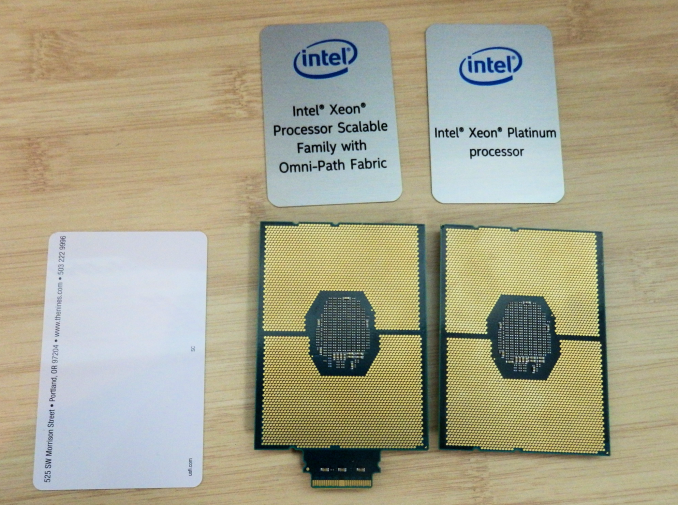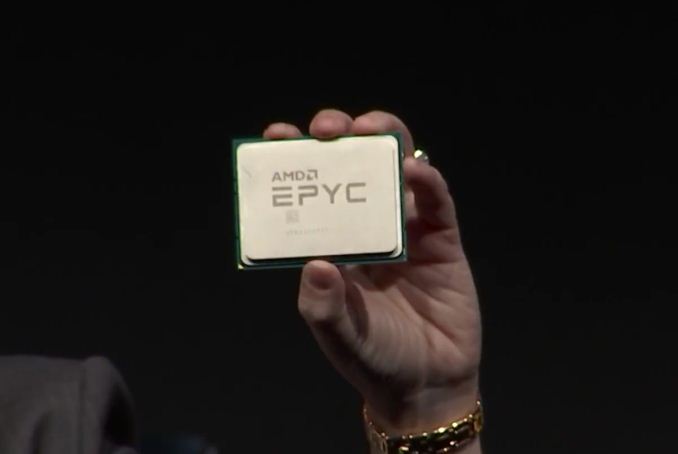Sizing Up Servers: Intel's Skylake-SP Xeon versus AMD's EPYC 7000 - The Server CPU Battle of the Decade?
by Johan De Gelas & Ian Cutress on July 11, 2017 12:15 PM EST- Posted in
- CPUs
- AMD
- Intel
- Xeon
- Enterprise
- Skylake
- Zen
- Naples
- Skylake-SP
- EPYC

This morning kicks off a very interesting time in the world of server-grade CPUs. Officially launching today is Intel's latest generation of Xeon processors, based on the "Skylake-SP" architecture. The heart of Intel's new Xeon Scalable Processor family, the "Purley" 100-series processors incorporate all of Intel's latest CPU and network fabric technology, not to mention a very large number of cores.
Meanwhile, a couple of weeks back AMD soft-launched their new EPYC 7000 series processors. Based on the company's Zen architecture and scaled up to server-grade I/O and core counts, EPYC represents an epic achievement for AMD, once again putting them into the running for competitive, high performance server CPUs after nearly half a decade gone. EPYC processors have begun shipping, and just in time for today's Xeon launch, we also have EPYC hardware in the lab to test.
Today's launch is a situation that neither company has been in for quite a while. Intel hasn't had serious competition in years, and AMD has't been able to compete. As a result, both companies are taking the other's actions very seriously.
In fact we could go on for much longer than our quip above in describing the rising tension at the headquarters of AMD and Intel. For the first time in 6 years (!), a credible alternative is available for the newly launched Xeon. Indeed, the new Xeon "Skylake-SP" is launching today, and the yardstick for it is not the previous Xeon (E5 version 4), but rather AMD's spanking new EPYC server CPU. Both CPUs are without a doubt very different: micro architecture, ISA extentions, memory subsystem, node topology... you name it. The end result is that once again we have the thrilling task of finding out how the processors compare and which applications their various trade-offs make sense.
The only similarity is that both server packages are huge. Above you see the two new Xeon packages –with and without an Omni-Path connector – both of which are as big as a keycard. And below you can see how one EPYC CPU fills the hand of AMD's CEO Dr. Lisa Su.
Both are 64 bit x86 CPUs, but that is where the similarities end. For those of you who have been reading Ian's articles closely, this is no surprise. The consumer-focused Skylake-X is the little brother of the newly launched Xeon "Purley", both of which are cut from the same cloth that is the Skylake-SP family. In a nutshell, the Skylake-SP family introduces the following new features:
- AVX-512 (Many different variants of the ISA extension are available)
- A 1 MB (instead of a 256 KB) L2-cache with a non-inclusive L3
- A mesh topology to connected the cores and L3-cache chunks together
Meanwhile AMD's latest EPYC Server CPU was launched a few weeks ago:
On the package are four silicon dies, each one containing the same 8-core silicon we saw in the AMD Ryzen processors. Each silicon die has two core complexes, each of four cores, and supports two memory channels, giving a total maximum of 32 cores and 8 memory channels on an EPYC processor. The dies are connected by AMD’s newest interconnect, the Infinity Fabric...
In the next pages, we will be discussing the impact of these architectural choices on server software.











219 Comments
View All Comments
StargateSg7 - Sunday, August 6, 2017 - link
Maybe I'm spoiled, but to me a BIG database is something I usually deal with on a daily basissuch as 500,000 large and small video files ranging from two megabytes to over a PETABYTE
(1000 Terabytes) per file running on a Windows and Linux network.
What sort of read and write speeds do we get between disk, main memory and CPU
and when doing special FX LIVE on such files which can be 960 x 540 pixel youtube-style
videos up to full blown 120 fps 8192 x 4320 pixel RAW 64 bits per pixel colour RGBA files
used for editing and video post-production.
AND I need for the smaller files, total I/O-transaction rates at around
OVER 500,000 STREAMS of 1-to-1000 64 kilobyte unique packets
read and written PER SECOND. Basically 500,000 different users
simultaneously need up to one thousand 64 kilobyte packets per
second EACH sent to and read from their devices.
Obviously Disk speed and network comm speed is an issue here, but on
a low-level hardware basis, how much can these new Intel and AMD chips
handle INTERNALLY on such massive data requirements?
I need EXABYTE-level storage management on a chip! Can EITHER
Xeon or EPyC do this well? Which One is the winner? ... Based upon
this report it seems multiple 4-way EPyC processors on waterblocked
blades could be racked on a 100 gigabit (or faster) fibre backbone
to do 500,000 simultaneous users at a level MUCH CHEAPER than
me having to goto IBM or HP for a 30+ million dollar HPC solution!
PixyMisa - Tuesday, July 11, 2017 - link
It seems like a well-balanced article to me. Sure the DB performance issue is a corner case, but from a technical point of view its worth knowing.I'd love to see a test on a larger database (tens of GB) though.
philehidiot - Wednesday, July 12, 2017 - link
It seems to me that some people should set up their own server review websites in order that they might find the unbiased balance that they so crave. They might also find a time dilation device that will allow them to perform the multitude of different workload tests they so desire. I believe this article stated quite clearly the time constraints and the limitations imposed by such constraints. This means that the benchmarks were scheduled down to the minute to get as many in as possible and therefore performing different tests based on the results of the previous benchmarks would have put the entire review dataset in jeopardy.It might be nice to consider just how much data has been acquired here, how it might have been done and the degree of interpretation. It might also be worth considering, if you can do a better job, setting up shop on your own and competing as obviously the standard would be so much higher.
Sigh.
JohanAnandtech - Thursday, July 13, 2017 - link
Thank you for being reasonable. :-) Many of the benchmarks (Tinymembench, Stream, SPEC) etc. can be repeated, so people can actually check that we are unbiased.Shankar1962 - Monday, July 17, 2017 - link
Don't go by the labs idiotUnderstand what real world workloads are.....understand what owning an entire rack means ......you started foul language so you deserve the same respect from me......
roybotnik - Wednesday, July 12, 2017 - link
EPYC looks extremely good here aside from the database benchmark, which isn't a useful benchmark anyways. Need to see the DB performance with 100GB+ of memory in use.CarlosYus - Friday, July 14, 2017 - link
A detailed and unbiased article. I'm awaiting for more tests as testing time passes.3.2 Ghz is a moderate Turbo for AMD EPYC, I think AMD could push it further with a higher thermal envelope i/o 14 nm process improvement in the coming months.
mdw9604 - Tuesday, July 11, 2017 - link
Nice, comprehensive article. Glad to see AMD is competitive once again in the server CPU space.nathanddrews - Tuesday, July 11, 2017 - link
"Competitive" seems like an understatement, but yes, AMD is certainly bringing it!ddriver - Tuesday, July 11, 2017 - link
Yeah, offering pretty much double the value is so barely competitive LOL.